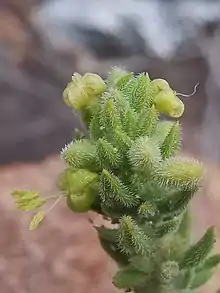Anthospermeae
Anthospermeae is a tribe of flowering plants in the family Rubiaceae and contains 208 species in 12 genera. Its representatives are found in the Southern Hemisphere, with the exception of the two species of the genus Phyllis.[1] At least two genera, namely Coprosma and Galopina are anemophilous.[2]
| Anthospermeae | |
|---|---|
 | |
| Anthospermum hispidulum | |
| Scientific classification | |
| Kingdom: | Plantae |
| Clade: | Tracheophytes |
| Clade: | Angiosperms |
| Clade: | Eudicots |
| Clade: | Asterids |
| Order: | Gentianales |
| Family: | Rubiaceae |
| Subfamily: | Rubioideae |
| Tribe: | Anthospermeae Cham. & Schltdl. ex DC. |
Genera
Currently accepted names[1][3][4][5]
- Anthospermum L. (39 sp)
- Carpacoce Sond. (7 sp)
- Coprosma J.R.Forst. & G.Forst. (110 sp)
- Durringtonia R.J.F.Hend. & Guymer (1 sp)
- Galopina Thunb. (4 sp)
- Leptostigma Arn. (7 sp)
- Nenax Gaertn. (9 sp)
- Nertera Banks ex Sol. (10 sp)
- Normandia Hook.f. (1 sp)
- Opercularia Gaertn. (17 sp)
- Phyllis L. (2 sp)
- Pomax Sol. ex DC. (1 sp)
Synonyms
- Ambraria Cruse = Nenax
- Ambraria Heist. ex Fabr. = Anthospermum
- Bupleuroides Moench = Phyllis
- Caprosma G.Don = Coprosma
- Corynula Hook.f. = Leptostigma
- Cryptospermum Young = Opercularia
- Cunina C.Gay = Nertera
- Erythrodanum Thouars = Nertera
- Eurynome DC. = Coprosma
- Gomozia Mutis ex L.f. = Nertera
- Lagotis E.Mey. = Carpacoce
- Marquisia A.Rich. ex DC. = Coprosma
- Nobula Adans. = Phyllis
- Oxyspermum Eckl. & Zeyh. = Galopina
- Pelaphia Banks & Sol. ex A.Cunn. = Coprosma
- Peratanthe Urb. = Nertera
- Rubioides Sol. ex Gaertn. = Opercularia
References
- "World Checklist of Rubiaceae". Retrieved 13 April 2016.
- Ronse De Craene, Louis P. (2010). Floral Diagrams: An Aid to Understanding Flower Morphology and Evolution. Cambridge: Cambridge University Press. p. 319. ISBN 9781139484558.
- Bremer B (2009). "A review of molecular phylogenetic studies of Rubiaceae". Annals of the Missouri Botanical Garden. 96: 4–26. doi:10.3417/2006197. S2CID 53378010.
- Bremer B, Eriksson E (2009). "Time tree of Rubiaceae: phylogeny and dating the family, subfamilies, and tribes". International Journal of Plant Sciences. 170 (6): 766–793. doi:10.1086/599077. S2CID 49332892.
- Robbrecht E, Manen J-F (2006). "The major evolutionary lineages of the coffee family (Rubiaceae, angiosperms). Combined analysis (nDNA and cpDNA) to infer the position of Coptosapelta and Luculia, and supertree construction based on rbcL, rps16, trnL-trnF and atpB-rbcL data. A new classification in two subfamilies, Cinchonoideae and Rubioideae". Systematic Geography of Plants. 76: 85–146.
This article is issued from Wikipedia. The text is licensed under Creative Commons - Attribution - Sharealike. Additional terms may apply for the media files.